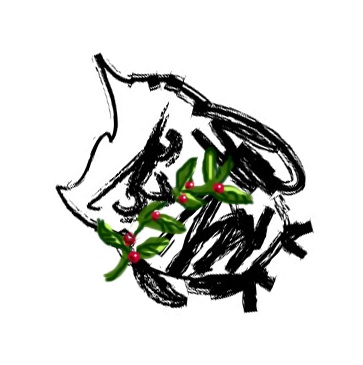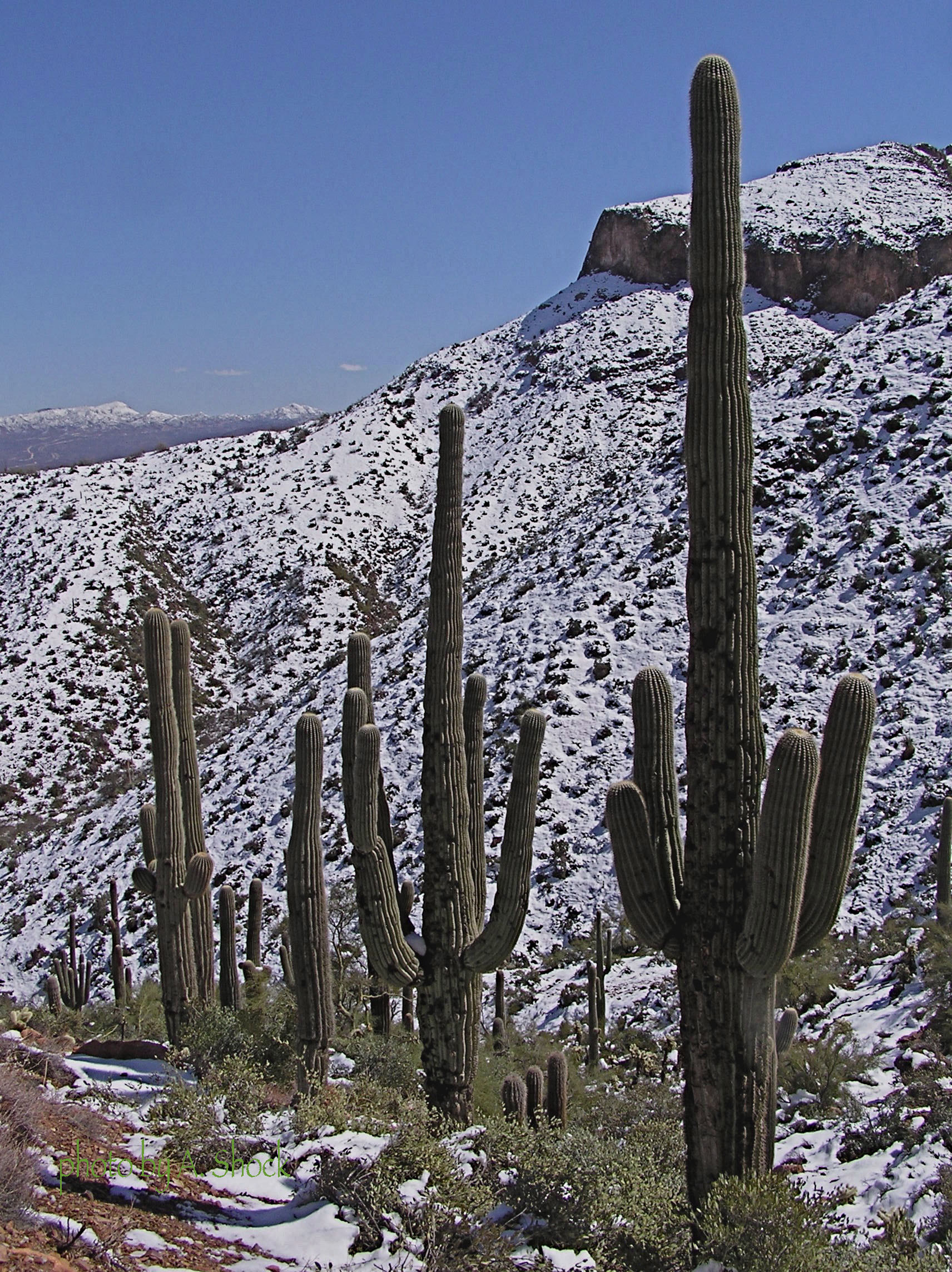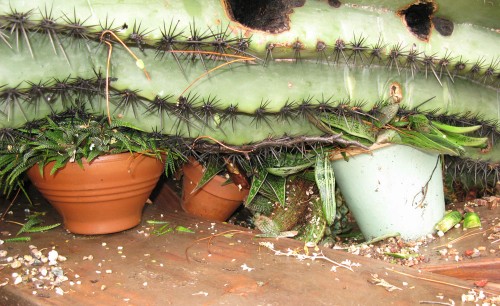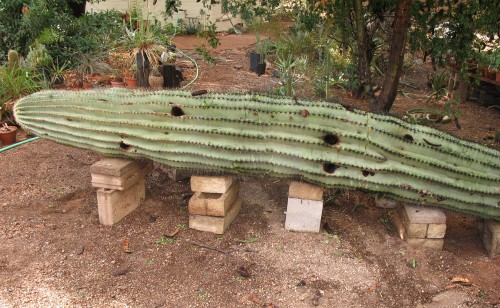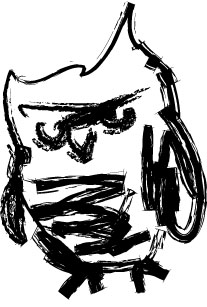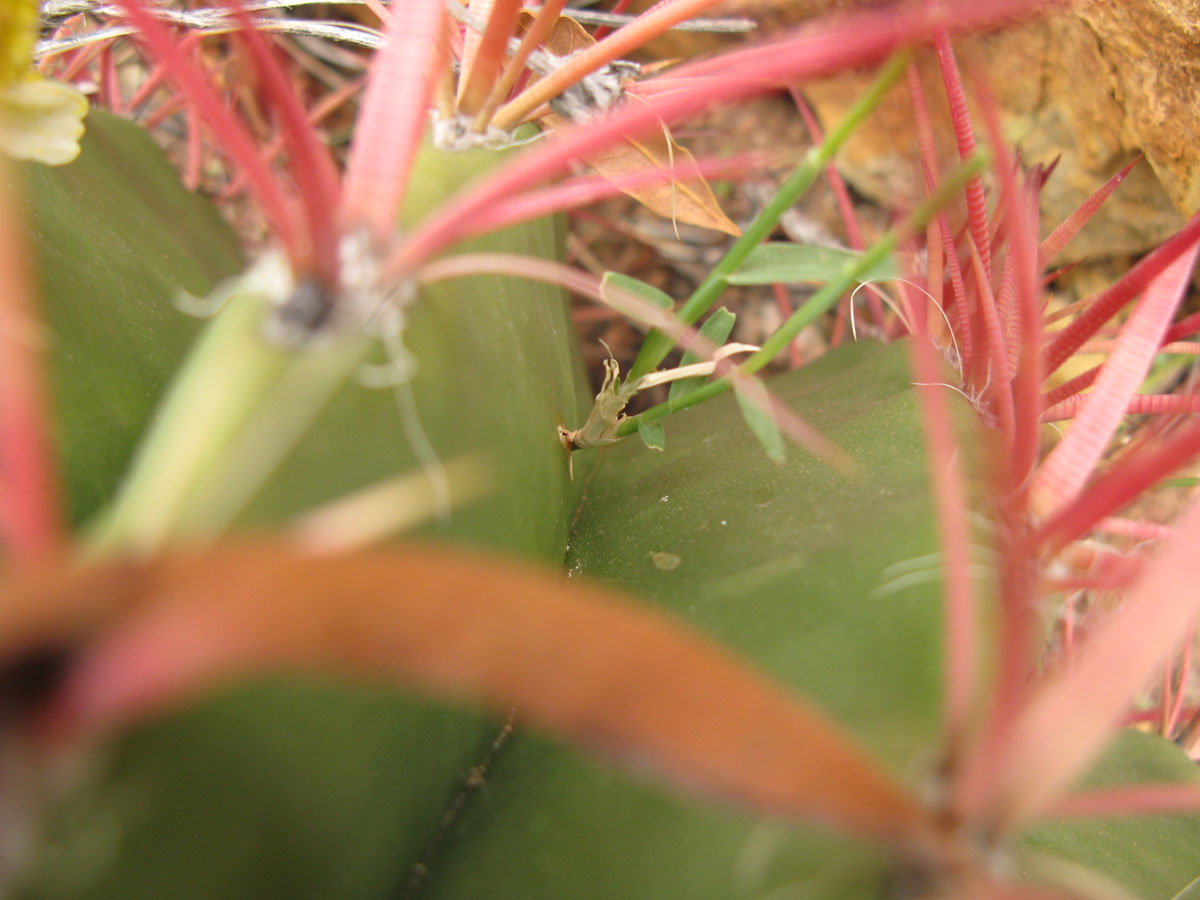Author
 Allison does not consider herself a wildlife artist,
but an observer who takes notes in clay.
More info...
Allison does not consider herself a wildlife artist,
but an observer who takes notes in clay.
More info...
Thanksgiving saguaro plunge–Carnegiea carnage
It was leaning, but not that much. On Thanksgiving morning while we had breakfast (E, the M, and me), it fell with a huge thump from no particular direction.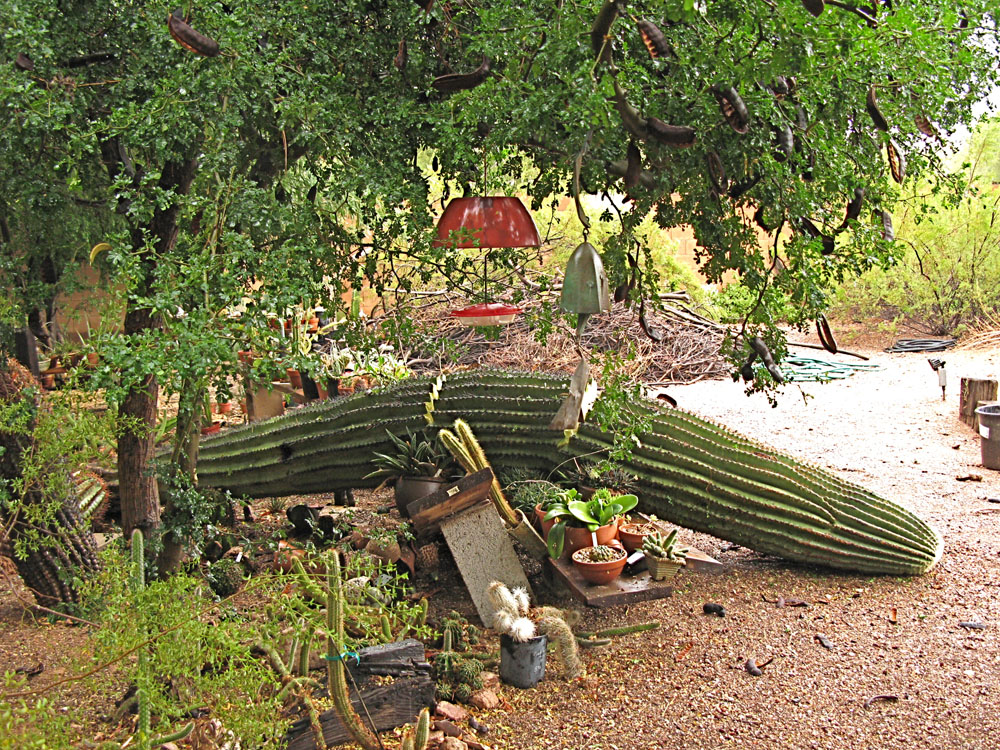 Later, E found the saguaro (Carnegiea gigantea): under the back mesquite, lying split like a toppled Doric column on top of beloved cax and sux, some in the ground, some in pots on shelves. Its weight had splintered a 2×12 pine shelf, cracking it nearly in two. It popped a mature barrel cactus out of the ground roots and all, and launched pots in the air, so that they landed in uprooted piles. It took all three of us to dig out the victims pinned under the wreckage, embedded in green flesh, impaled on spines. Lots of crushed plants, but only two pots lost and only one hand-made one; a small clay “miracle”. Still, it was gruesome, and the saguaro, although probably 50 years old, wasn’t anywhere near the end of its expected life span. It hadn’t even grown arms yet, like some of the older saguaros in this mature desert neighborhood.
Later, E found the saguaro (Carnegiea gigantea): under the back mesquite, lying split like a toppled Doric column on top of beloved cax and sux, some in the ground, some in pots on shelves. Its weight had splintered a 2×12 pine shelf, cracking it nearly in two. It popped a mature barrel cactus out of the ground roots and all, and launched pots in the air, so that they landed in uprooted piles. It took all three of us to dig out the victims pinned under the wreckage, embedded in green flesh, impaled on spines. Lots of crushed plants, but only two pots lost and only one hand-made one; a small clay “miracle”. Still, it was gruesome, and the saguaro, although probably 50 years old, wasn’t anywhere near the end of its expected life span. It hadn’t even grown arms yet, like some of the older saguaros in this mature desert neighborhood.
In order to remove the plants from under it, we had to prop the saguaro incrementally up onto cinder blocks, where it now lies abandoned like an old car, awaiting decomposition, its length unnaturally separated from the soil below. Sadly, as damaged as it is, it looks very whole even lying there, and a few of its roots, still buried in the damp desert soil, are so far keeping it green and living, a support system that won’t bring life back.
Close in — tiny mud pot forms on wall
 Every once in a while, I find a clay pot — a tiny, perfect clay pot — on the wall of the house. They look like little half-buried Mediterranean amphorae, without handles, with a narrow neck and a flared rim, the entire thing only half an inch across. But they have no openings: like the false-necked vessels drachmai-conscious Athenian families left at the graves of loved ones — they looked full of precious oil while only actually containing a thimbleful — these tiny pots are sealed at the top. Sometimes, however, they have a hole in the side, as if a micro-tomb-robber struck the belly of the pot with a spade, to sift through the contents.
Every once in a while, I find a clay pot — a tiny, perfect clay pot — on the wall of the house. They look like little half-buried Mediterranean amphorae, without handles, with a narrow neck and a flared rim, the entire thing only half an inch across. But they have no openings: like the false-necked vessels drachmai-conscious Athenian families left at the graves of loved ones — they looked full of precious oil while only actually containing a thimbleful — these tiny pots are sealed at the top. Sometimes, however, they have a hole in the side, as if a micro-tomb-robber struck the belly of the pot with a spade, to sift through the contents.
A little spadework in books and on the internet turned up the answer to who the tiny potters in our yard might be : Microdynerus arenicolus, the Antioch Potter Wasp, who builds up this mud cell for its offspring one mouthful of clay at a time.
You would think a wasp bringing mouthful after mouthful of mud to a wall right by the front door might be observed easily, but I’ve never knowingly seen one of these wasps on the job. What I can glean about the appearance and habits of the Antioch Potter Wasp is that they are about half-an-inch long, live in California, southern Arizona and New Mexico, and are solitary wasps. 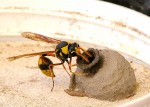 The adults have creamy white or yellow and black markings, and there are subtle differences in coloring and morphology between males and females that are probably mostly important to other wasps and entomologists. (The photo on the left is not our Potter Wasp, it’s a related species from Australia.) The females have stingers, but are “docile”. They are also “domestic”: it’s the female who does all the housework. Here’s what an Arizona Game and Fish document says about the Antioch Potter Wasp:
The adults have creamy white or yellow and black markings, and there are subtle differences in coloring and morphology between males and females that are probably mostly important to other wasps and entomologists. (The photo on the left is not our Potter Wasp, it’s a related species from Australia.) The females have stingers, but are “docile”. They are also “domestic”: it’s the female who does all the housework. Here’s what an Arizona Game and Fish document says about the Antioch Potter Wasp:
These are solitary wasps, each female constructing nests and provisioning them for her own offspring. Each nest looks like a small jug, about half an inch in diameter, with a short sealed neck. When the female decides to make a cell, she selects a sheltered place, and then carries dollops of mud there for construction. This is a precision process with a thin walled pot resulting. When the pot is almost completed, with just room for her to get her head in, she starts to provision the cell with hairless caterpillars, which she has paralyzed by stinging them in the central nervous system. Once the cell is full she lays an egg on the prey and restarts the cell making process. She adds mud to the edges of the nearly spherical pot. Closing the sphere presents problems that are solved by simply adding extra mud and leaving a small neck. The larva that hatches from the egg eats the prey, spins a cocoon inside the pot and pupates. When the new adult is ready to leave the pot, it simply makes a hole in the side and leaves. Using the neck would be logical but that is where the pot is the thickest.
–Arizona Game and Fish Department. 2004. Microdynerus arenicolus. Unpublished abstract compiled and edited by the Heritage Data Management System, Arizona Game and Fish Department, Phoenix, AZ. 4 pp.
Unless you’re a hairless caterpillar, this is a fascinating process. Especially for a potter: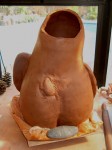 the technique of building a pot from the bottom up, adding little bits of clay at a time, and contouring it as you go is exactly the technique potters use to build vessels or vessel-like sculptures. Vessels of any size and shape can be made as long as the supply of moist clay holds out: the potter wasp makes her own by carrying a mouthful of water to a dry clay source and mixing it up to the right consistency and carrying it to the construction site. To the right is a picture of a Three Star Owl VLO (Very Large Owl) being constructed in the same way as a potter wasp builds her nest. (It will be more than two feet tall and at this point lacked its face. Please note that the finished owl sculpture was not provisioned with hairless caterpillars nor were any eggs at all laid during the process.)
the technique of building a pot from the bottom up, adding little bits of clay at a time, and contouring it as you go is exactly the technique potters use to build vessels or vessel-like sculptures. Vessels of any size and shape can be made as long as the supply of moist clay holds out: the potter wasp makes her own by carrying a mouthful of water to a dry clay source and mixing it up to the right consistency and carrying it to the construction site. To the right is a picture of a Three Star Owl VLO (Very Large Owl) being constructed in the same way as a potter wasp builds her nest. (It will be more than two feet tall and at this point lacked its face. Please note that the finished owl sculpture was not provisioned with hairless caterpillars nor were any eggs at all laid during the process.)
I determined to keep an eye on the little wasp-pot, hoping to see a new wasp break free and fly away, to carry on the work of potter wasps in the yard. Of course, the next time I looked, there was the hole, and the empty belly of the tiny clay amphora — the wasp had flown. Here’s a picture of the hole made from the inside out by the wasp itself, not a grave robber after all: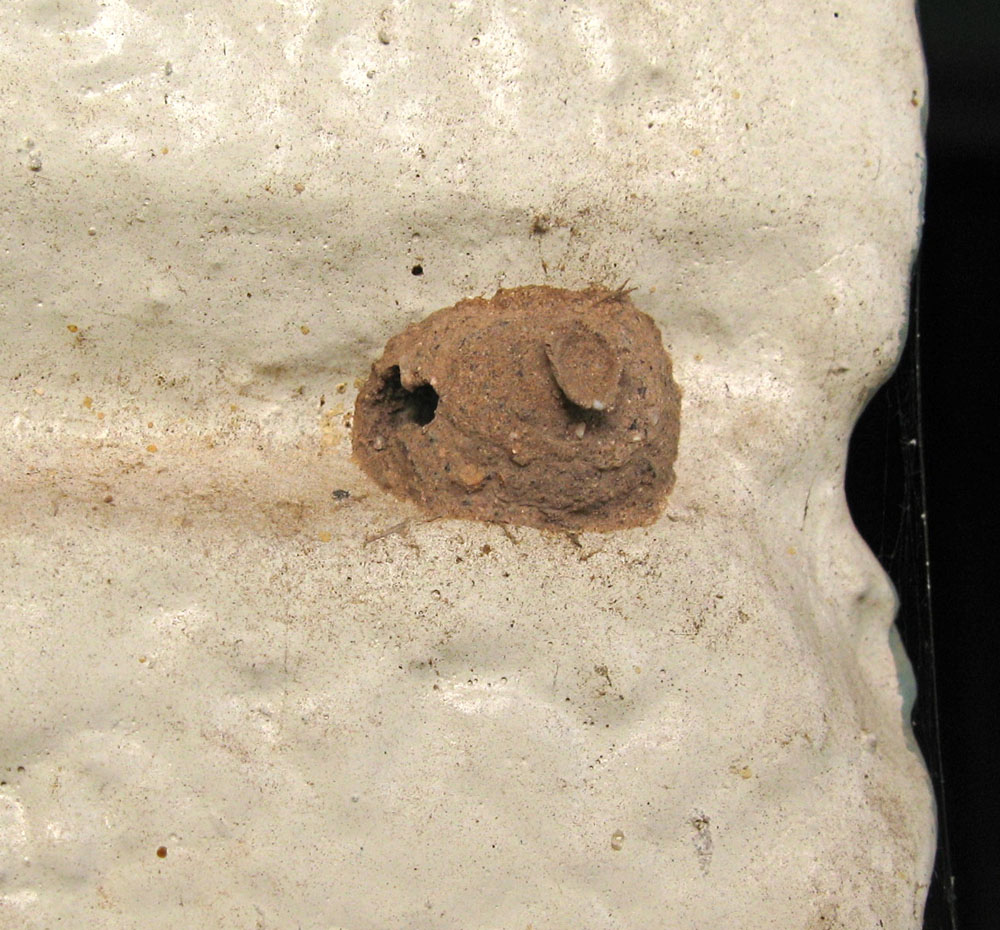
Etymology
The common name, Antioch Potter Wasp, seems like a very appropriately Mediterranean name for an organism that makes structures that look like amphorae, the storage and shipping vessels found all over the Mediterranean region from about the 13th century BC until the 7th century AD. But it’s mere coincidence, and not connected with the ancient city of Antioch on the Levantine coast of the Mediterranean (the stretch of land from which the earliest amphorae, the so-called “Canaanite jars”, come), a hub of commerce and shipping. The species was given its name from the town of Antioch, California, also a hub of commerce and shipping, where the type specimen was collected and described.
(Photos: #1, 3, 4, A.Shock, Three Star Owl. #2, from the following site: http://www.geocities.com/brisbane_wasps/images/MudDau7.jpg, no photo credit found)
Botanical horrors: when grass grows bad
Here is a photo of a lovely Red barrel cactus in Miss Thang’s garden.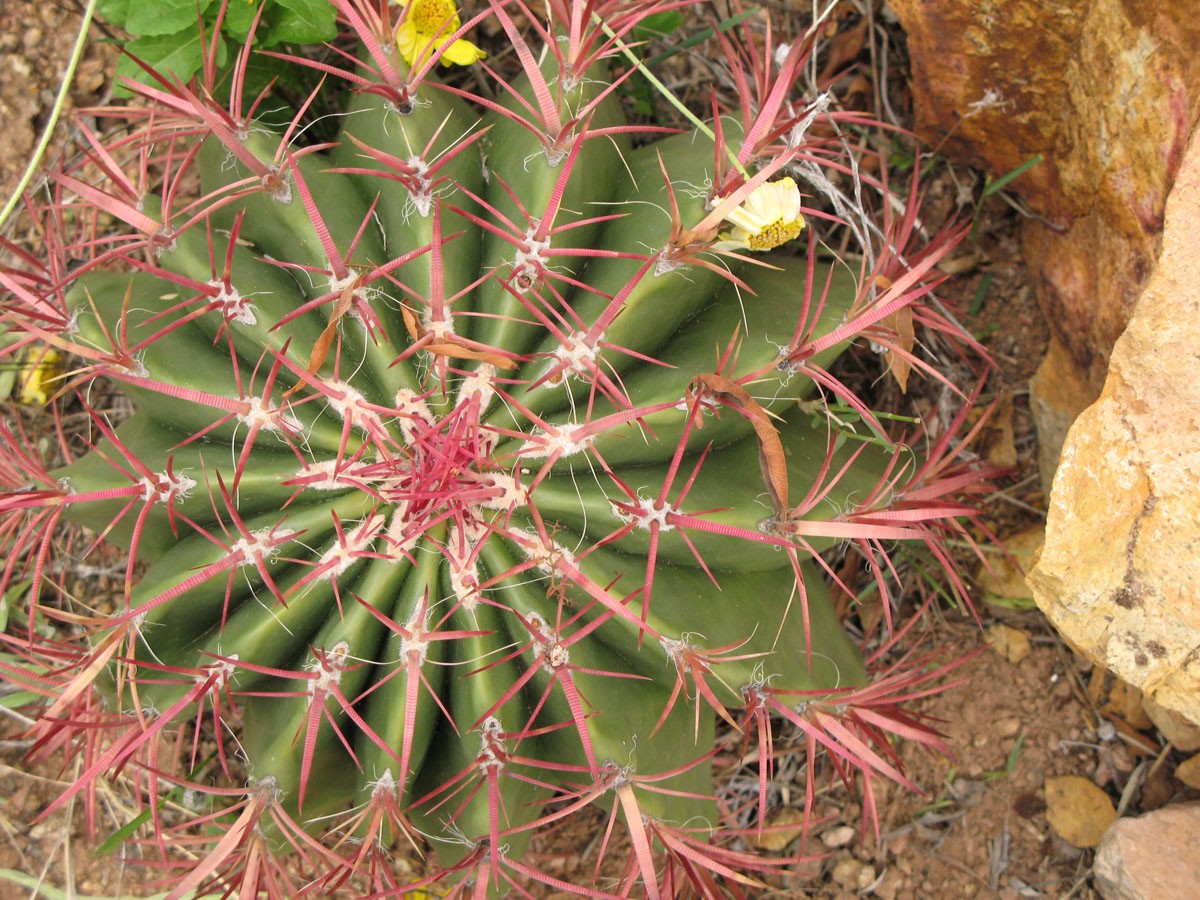
The barrel is happy where it is, and is growing quickly and healthily. Unfortunately, we’ve had a Bermuda Grass invasion nearby, and despite E‘s manual, non-toxic efforts to control the grass, it’s spread up to the Red Barrel. It was bad enough when the awful spikes of grass began to come up around the fat base of the cactus, but look closely — at about 3 o’clock on the shadowy right side of the barrel, there is a double spike of insidious grassy green poking out between the cactus’s ribs, inside the cage of the spines. That is a Bermuda grass shoot growing out through the side of the barrel! The horrid monocot grew around and under the cactus, and sent up sharp new shoots through its flesh and out its skin about 4 inches up from the soil line, where it’s now established itself contentedly at the expense of the barrel’s structural integrity. I imagine roots spreading through the interior of the cactus, sucking moisture without remorse.
If you can stand it, here is a close-up, click on the image to enlarge it.

